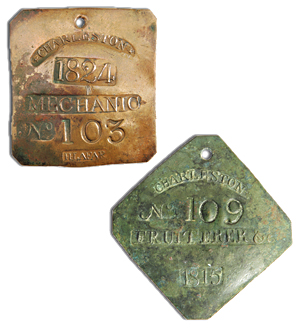|
"Making Cents"
The Signal
Saturday, July 15, 2006
| O |
The city earned a fee of $2 per year, per tag, and the slave owner earned a fee for the slave's earnings as a leased-out laborer.
In a recent sale by Heritage Galleries of Texas, a major collection of 33 of these tags came on the market. The estimated values ranged from $2.000 to more than $10,000 per tag.
The tags came in various shapes — round, diamond and square with cut corners. Each bore a number of issue, the name of Charleston, South Carolina (or Charleston Neck), and the year of issue. Each tag was holed at the top and was required to be worn by the hired slave during his or her period of servitude.
It was believed until recently that just over 100 of these tags existed, with the last large collection of 14 pieces sold in the John J. Ford collection in 1993. Most of the known pieces reside in museums. According to Russ Rulau's 1999 edition of "United States Tokens," a grand total of 103 pieces were known at the time.
The various known occupations for slave tags include servant, porter, carpenter (rare), mechanic, fruiterer (very rare), fisher (rare), cook (rare), drayman (rare) and seamstress (rare). A couple of other trades are believed to exist, but no specimen is known today.
Charleston had 15,354 slaves in 1830 and 14,673 in 1840. About 12 to 20 percent saw work as hired-out slaves during that period. The Charleston Museum has 36 tags and the American Numismatic Society has seven tags.
In Rulau's book, reference is made to both modern and contemporary counterfeits of these pieces, which show up at swap meets and at non-numismatic venues.
Genuine, historic pieces represent a key element in our history, and they are highly prized by collectors, historians and museums.
Dr. Sol Taylor of Sherman Oaks is president of the Society of Lincoln Cent Collectors and author of The Standard Guide to the Lincoln Cent. Click here for ordering information.
©2006, THE SIGNAL · ALL RIGHTS RESERVED.

![[Most Recent Quotes from www.kitco.com]](http://www.kitconet.com/images/quotes_special.gif)

